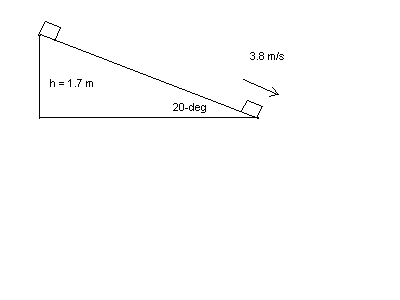
| FALL '11 TEST 3 SOLUTIONS | |
|
From Autumn 99 |
Solutions to Real Test 2 |
1. (20 points) Ch. 5
A 2.10 x 103 kg box starts from rest at the top of a long drive way of length L from a vertical height h = 1.7 m. The driveway makes an angle of 20-degrees with the horizontal. At the bottom of the hill, the speed of the box is 3.8 m/s.
Please use the conservation of energy methods of Ch. 5 in the presence of friction.
What is the coefficient of kinetic friction between the block and the incline?

| Solution Outline: K1 + U1 = K2 + U2 + Heat 0 + mgh = ½ mv22 + 0 +µmgcos20*L 0 + mgh = ½ mv22 + 0 +µmgcos20*h/sin20 Note that L =h/sin20 since h = Lsin20 Solve for µ. |
2. (20 points) Ch. 6
A billiard ball (of mass m) rolling across a table at 1.50 m/s makes an elastic head on collision with an identical ball. (of the same mass m!).
(a) (16 points) Find the velocity of each ball if the second ball
is moving toward the
first at a speed of 1.00 m/s.
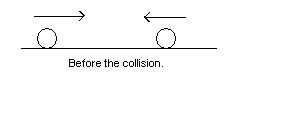
(b) (2 points) What is the direction of motion of the first ball after the
collision, to
the right or left?
(c) (2 points) What is the direction of motion of the second ball after the
collision, to
the right or left?
| Solution outline: Note that the masses cancel, so Note that v1i = 1.5 m/s and v2i
= -1.0 m/s |
3. (20 points) Ch. 6
A 15.0 g bullet with initial speed 270 m/s (just before the collision) is fired into a 80-g wooden block that is initially at rest on a horizontal frictionless surface and is connected to a spring of spring constant k. The bullet sticks inside the block after the collision.
Suppose that the spring compresses a maximum distance 0.75 m after the collision.
What is k?
For a diagram, see this:
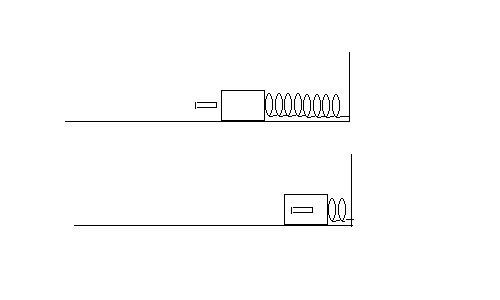
| Solution outline: m = 0.015 kg , M = 0.080 kg , V = 270 m/s and x = 0.75 m. First use conservation of momentum: mV = (m + M)Vf Solve for Vf ½(m + M)Vf2 = ½kx2 . Solve for k
|
4. (20 points) Ch. 7
Two masses are shown below on a line, separated by a distance of 12.0 m. The mass values are indicated in the diagram. Find the distance from the left mass at which an object can be placed so that the net gravitational force is zero.
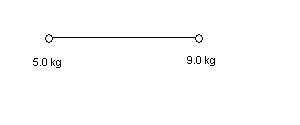
| Solution outline: Please see
problem 34 just like this in Quiz 6. Same problem, different numbers. |
5. Credit (8 points) Ch. 8
The beam below has mass 25 kg. Find the tension T in the cable.
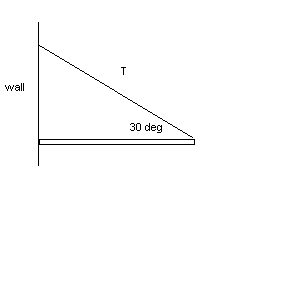
| Solution outline: This problem could appear
on the test as extra credit on the test Monday as extra credit
only. However, you should also study the other problems you are
working on in Ch. 8 as possible extra credit problems. Please see the
example in the book. This problem is easier because there is no
extra mass in the form of a person standing on the beam to complicate
matters.
Find the tension in the cable. Take torques on the beam about the axis at the left end of the beam attached to the wall. Sum of the torques = 0 = pos - neg 0 = torque of tension - torque of beam mass 0 = T*Lsin30 - mg*L/2 , Solve for T = mg/2*sin30 |